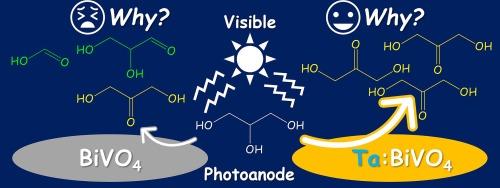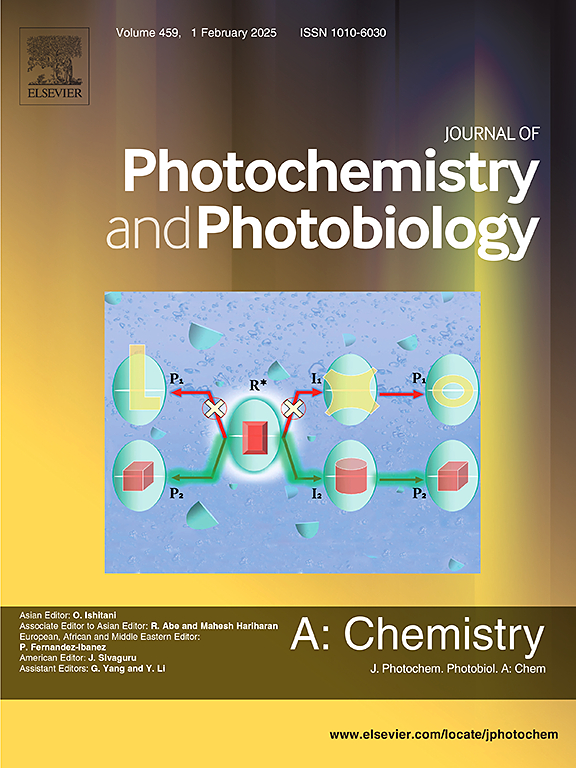钒酸铋光阳极上的甘油氧化机制:掺杂钽的影响
IF 4.1
3区 化学
Q2 CHEMISTRY, PHYSICAL
Journal of Photochemistry and Photobiology A-chemistry
Pub Date : 2024-11-08
DOI:10.1016/j.jphotochem.2024.116143
引用次数: 0
摘要
本研究利用密度泛函理论计算研究了甘油在 BiVO4 和 Bi-O-Ta 物种上光电化学氧化成二羟基丙酮(DHA)和甘油醛(GLAD)的机理。结果表明,对于两种产物和金属氧化物而言,形成碳中心自由基的第一个质子耦合电子转移(PCET)步骤是限速步骤。与一级碳中心自由基形成 GLAD 相比,二级碳中心自由基形成 DHA 所遇到的能量障碍更低,这表明 DHA 的生成途径更为有利。与 BiVO4 相比,Bi-O-Ta 物种生产 DHA 和 GLAD 所需的能量输入差异更大。此外,通过 GLAD 从甘油中生产甲酸(FA)涉及三个 H2O 分子和八个 PCET 步骤,在 Bi-O-Ta 物种上遇到的能量障碍比在 BiVO4 上更大。这些计算结果证实,Bi-O-Ta 物种在抑制 GLAD 和 FA 等不利副产物产生的同时,提高了从甘油中生成 DHA 的能力。相应地,由于表面形成了 Bi-O-Ta 物种,掺杂 Ta 的 BiVO4 光阳极比 BiVO4 光阳极的法拉第效率更高,在酸性介质中对 DHA 的选择性约为 100%。本文章由计算机程序翻译,如有差异,请以英文原文为准。

Mechanism of glycerol oxidation on bismuth vanadate photoanodes: Influence of tantalum doping
This study investigated the mechanisms underlying the photoelectrochemical oxidation of glycerol to dihydroxyacetone (DHA) and glyceraldehyde (GLAD) on BiVO4 and Bi–O–Ta species using density functional theory calculations. The results revealed that for both products and metal-oxides, the first proton-coupled electron-transfer (PCET) step, which forms a carbon-centered radical, served as the rate-limiting step. The formation of DHA from a secondary-carbon-centered radical encountered lower energy barriers compared to the formation of GLAD from a primary-carbon-centered radical, indicating the favorability of the DHA production pathway. The differences between the energy inputs required for DHA and GLAD production were greater on the Bi–O–Ta species compared to the BiVO4. Furthermore, the production of formic acid (FA) from glycerol via GLAD, involving three H2O molecules and eight PCET steps, encountered greater energy barriers on Bi–O–Ta species than on BiVO4. These computational results confirm that the Bi–O–Ta species enhances DHA generation from glycerol while suppressing the production of unfavorable byproducts such as GLAD and FA. Correspondingly, the Ta-doped BiVO4 photoanode achieves a greater Faradaic efficiency than the BiVO4 photoanode and approximately 100% selectivity for DHA in acidic media owing to the Bi–O–Ta species formed on the surface.
求助全文
通过发布文献求助,成功后即可免费获取论文全文。
去求助
来源期刊
CiteScore
7.90
自引率
7.00%
发文量
580
审稿时长
48 days
期刊介绍:
JPPA publishes the results of fundamental studies on all aspects of chemical phenomena induced by interactions between light and molecules/matter of all kinds.
All systems capable of being described at the molecular or integrated multimolecular level are appropriate for the journal. This includes all molecular chemical species as well as biomolecular, supramolecular, polymer and other macromolecular systems, as well as solid state photochemistry. In addition, the journal publishes studies of semiconductor and other photoactive organic and inorganic materials, photocatalysis (organic, inorganic, supramolecular and superconductor).
The scope includes condensed and gas phase photochemistry, as well as synchrotron radiation chemistry. A broad range of processes and techniques in photochemistry are covered such as light induced energy, electron and proton transfer; nonlinear photochemical behavior; mechanistic investigation of photochemical reactions and identification of the products of photochemical reactions; quantum yield determinations and measurements of rate constants for primary and secondary photochemical processes; steady-state and time-resolved emission, ultrafast spectroscopic methods, single molecule spectroscopy, time resolved X-ray diffraction, luminescence microscopy, and scattering spectroscopy applied to photochemistry. Papers in emerging and applied areas such as luminescent sensors, electroluminescence, solar energy conversion, atmospheric photochemistry, environmental remediation, and related photocatalytic chemistry are also welcome.

 求助内容:
求助内容: 应助结果提醒方式:
应助结果提醒方式:


